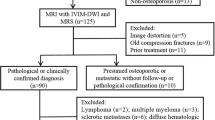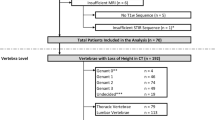Abstract
Objective
To assess the diagnostic value of perfusion MR imaging of diseased vertebrae by analysis of three parameters and the distribution of the time-intensity curve (TIC) patterns.
Design and patients
Dynamic MR imaging was performed on 34 patients with 48 lesions. All lesions were assigned to one of four groups: osteoporotic compression fracture, benign lesion without compression fracture, pathologic compression fracture, or metastatic lesion without fracture. Peak enhancement, steepest slope, and slope value were calculated from the TIC of diseased vertebrae. TICs were classified into five types. Comparisons were made among groups by analysis of the three parameters and the distributions of the TICs pattern.
Result
All parameters of pathologic compression fracture were significantly higher than those of osteoporotic compression fracture (P<0.05). The steepest slopes of metastatic lesions with and without pathologic compression fracture were significantly higher than those of benign lesions without compression fracture (P<0.05). No characteristic distribution of the TIC pattern helpful for the differentiation of benign and metastatic lesions was found.
Conclusion
In distinguishing osteoporotic from pathologic compression fractures, semiquantitative analysis of the perfusion MR imaging may be useful. However, the analysis of the TIC patterns can not significantly contribute to the differential diagnosis.



Similar content being viewed by others
References
Totty WG, Murphy WA, Lee JKT. Soft tissue tumors: MR imaging. Radiology 1986; 160:135–141.
Crim JR, Seeger LL, Yao L, et al. Diagnosis of soft-tissue masses be differentiated from malignant ones? Radiology 1992;185: 581–586.
Sundaram M, McGuire MH, Schajowicz F. Soft-tissue masses: histologic basis for decreased signal (short T2) on T2-weighted images. AJR Am J Roentgenol 1987; 148:1247–1250.
Erlemann R, Reiser MF, Peters PE, et al. Musculoskeletal neoplasm: static and dynamic Gd-DTPA-enhanced MR imaging. Radiology 1989; 171:767–773.
Erlemann R, Sciuk J, Bosse A, et al. Response of osteosarcoma and Ewing sarcoma to preoperative chemotherapy assessment with dynamic and static MR imaging and skeletal scintigraphy. Radiology 1990; 175:791–796.
Verstraete KL, De Deene Y, Roels H, et al. Benign and malignant musculoskeletal lesion: dynamic contrast-enhanced MR imaging-parametric “first-pass” images depict tissue vascularization and perfusion. Radiology 1994; 192:835–843.
Cova M, Kang YS, Tsukamoto H, et al. Bone marrow perfusion evaluated with gadolinium-enhanced dynamic fast MR imaging in a dog model. Radiology 1991; 179:535–539.
Fletcher BD, Hanna SL, Fairclough DJ, et al. Pediatric musculoskeletal tumors: use of dynamic, contrast-enhanced MR imaging to monitor response to chemotherapy. Radiology 1992; 184:243–248.
Van Der Woude HJ, Verstraete KL, Hoendoorn PC, Taminiau AH, Hermans J, Bloem JL. Musculoskeletal tumors: does fast dynamic contrast-enhanced subtraction MR imaging contribute to the characterization? Radiology 1998; 208:821–828.
Bollow VM, Knauf W, Korfel A, et al. Initial experience with dynamic MR imaging in evaluation of normal bone marrow versus malignant bone marrow infiltrations in humans. J Magn Reson Imaging 1997; 7:241–250.
Konig H, Sieper J, Wolf K. Rheumatoid arthritis: evaluation of hypervascular and fibrous pannus with dynamic MR imaging enhanced with Gd-DTPA. Radiology 1990; 176:473–477.
Verstraete KL, Van der Woude HJ, Hogendoorn PC, et al. Dynamic contrast-enhanced MR imaging of musculoskeletal tumors: basic principles and clinical applications. J Magn Reson Imaging 1996; 6:311–321.
Chen WT, Shih TT, Chen RC, et al. Blood perfusion of vertebral lesions evaluated with gadolinium-enhanced dynamic MRI: in comparison with compression fracture and metastasis. J Magn Reson Imaging 2002; 15:308–314.
Shin TT, Huang KM, Li YW. Solitary vertebral collapse: distinction between and malignant causes using MR patterns. J Magn Reson Imaging 1999; 9:635–642.
Yuh WTC, Zachar CK, Barloon TJ, et al. Vertebral compression fractures: distinction between benign and malignant causes with MR imaging. Radiology 1989; 172:215–218.
Shin TT, Tsuang YH, Huang KM, et al. Magnetic resonance imaging of vertebral compression fractures. J Formos Med Assoc 1996; 95:313–319.
Chen WT, Shih TTF, Chen RC, Lo SY, Chou CT, Lee JM, et al. Vertebral bone marrow perfusion evaluated with dynamic contrast-enhanced MR imaging: significance of aging and sex. Radiology 2001; 220:213–218.
Wolf GL. Contrast agents in spine and body MRI: introduction. In: Hasso AN, Stark DD, eds. American Roentgen Ray Society—Categorical course syllabus: spine and body magnetic resonance imaging—1991. Reston, VA: American Roentgen Ray Society, 1991:11–115.
Chen WT, Shin TTF, Chen RC, Lo SY, Chou CT, Lee JM, Tu HY. Vertebral bone marrow perfusion evaluated with dynamic contrast-enhanced MR imaging: significance of aging and sex. Radiology 2001; 220:213–218.
Montazel JL, Divine M, Lepage E, Kobeiter H, Breil S, Rahmouni A. Normal spinal bone marrow in adults: dynamic gadolinium-enhanced MR imaging. Radiology 2003; 229:703–709.
Baker LL, Goodman SB, Perkash I, Lane B, Enzman DR. Benign versus pathologic compression fractures of vertebral bodies: assessment with conventional spine-echo, chemical shift , and STIR imaging. Radiology 1990; 174:495–502.
Baur A, Stabler A, Bruning R, Bartl R, Krodel A, Reiser M, Deimling M. Diffusion-weighted MR imaging of bone marrow: differentiation benign versus pathologic compression fractures. Radiology 1998; 207:349-356.
Spuentrup E, Buecker A, Adam G, van Vaals J, Guenther RW. Diffusion-weighted MR imaging for differentiation of benign fracture edema and tumor infiltration of the vertebral body. AJR Am J Roentgenol 2001; 176:351–358.
Cruses RL, Dumount J. Healing of bone, tendon and ligament. In: Rockwood Jr CA, Green DP, eds. Fractures. Philadelphia: JB Lippincott, 1975:97–98.
Acknowledgement
Our grateful thanks go to Shuuichi Yamauchi and Kumi Ishihara, who were responsible for production of the MR images.
Author information
Authors and Affiliations
Corresponding author
Rights and permissions
About this article
Cite this article
Tokuda, O., Hayashi, N., Taguchi, K. et al. Dynamic contrast-enhanced perfusion MR imaging of diseased vertebrae: analysis of three parameters and the distribution of the time-intensity curve patterns. Skeletal Radiol 34, 632–638 (2005). https://doi.org/10.1007/s00256-005-0949-0
Received:
Revised:
Accepted:
Published:
Issue Date:
DOI: https://doi.org/10.1007/s00256-005-0949-0




